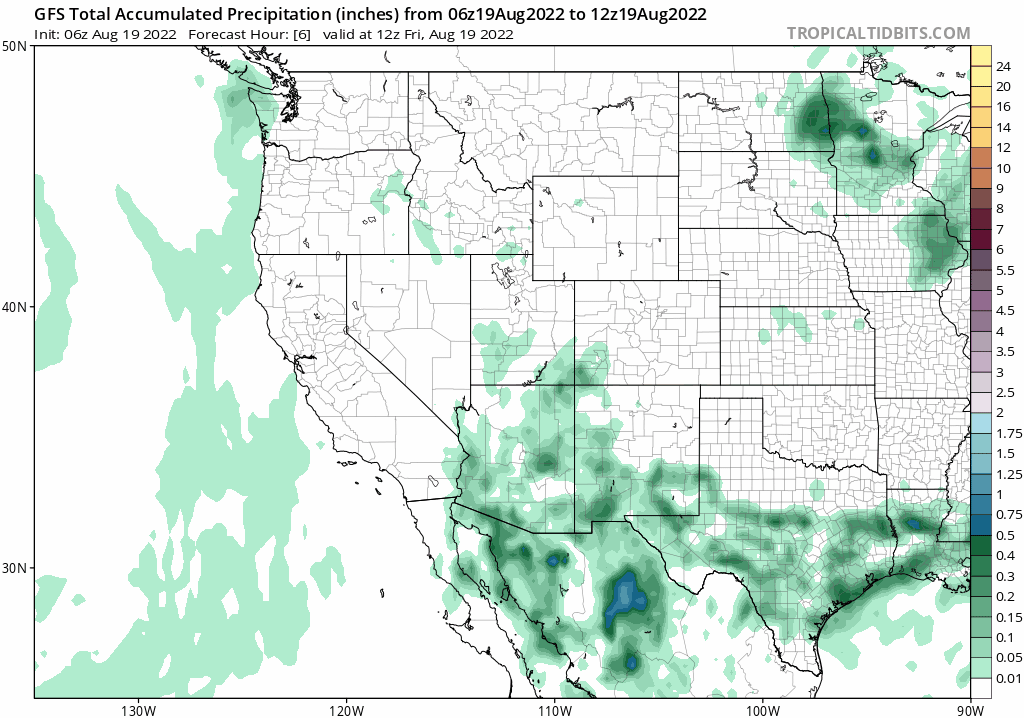9:00 AM | **The "Desert" Southwest is something of a misnomer in recent weeks…soaking rainfall this summer associated with the annual monsoon and now an influx of tropical moisture**
Paul Dorian
More significant rain is on the way for the Desert Southwest from Friday to the middle of next week thanks to a combination of monsoonal winds and an influx of tropical moisture. Maps courtesy NOAA, tropicaltidbits.com
Overview
The Desert Southwest has been anything but “desert-like” in recent weeks with copious amounts of rainfall associated with the annual monsoon season in the states of Arizona, New Mexico, Nevada, Utah and Colorado. Monsoons are well known in eastern Asia, but they also occur in other parts of the world including right here in the southwestern US. The typical time for the monsoon season in this country is from about mid-June to the end of September and it certainly got off to a quick start this year. In addition to monsoonal-aided rainfall, there will soon be an influx of tropical moisture that will contribute to additional heavy rainfall across the Southwest US and flash flooding is a serious concern.
Mexico and the southwestern US will likely receive additional heavy rainfall over the next 7 days or so with moist monsoonal winds and an influx of tropical moisture. Map courtesy NOAA/WPC
Monsoonal effects
Monsoons are generally associated with heavy rainfall amounts over an extended period of time in such countries as India, but the true definition refers to the change in wind direction that can trigger persistent rainfall or even dry weather for a long-duration. There are annual monsoonal impacts in places like eastern Asia, but they also take place in other parts of the world including right here in the southwestern part of the US. In the case of the Desert Southwest, the change in wind direction during the summer season brings moist air northward from Mexico that had its origins over the Gulf of Mexico and tropical eastern Pacific Ocean. The monsoon season actually got off to a quick start in the southwest US during the month of June with above-normal rainfall and that wet pattern has continued right into the middle of August. In some spots of the Desert Southwest, monsoonal rainfall brings an average of one-quarter to one-half of the average annual amount according to accuweather.com.
In recent weeks, the monsoonal pattern has brought downpours to portions of New Mexico, Nevada, Arizona, Utah and Colorado which has helped to alleviate longer-term drought conditions in the region. As an example, Las Vegas, Nevada is currently having its wettest monsoon season in about a decade and rainfall late last week generated flash flooding in the famous “strip” section of the city and 0.58 inches was recorded at the airport in an hour’s time - nearly double the normal amount for the month of August. In Albuquerque, New Mexico, the first half of August has featured 84% of its normal amount for the entire and the half an inch of rain that fell in Yuma, Arizona is already 260% of its normal for August (source accuweather.com). Even Death Valley, California got in on the action last week with heavy rainfall that caused flash flooding conditions in the national park where roads had to be closed for a short period of time.
Drought conditions in the SW US will no doubt be alleviated in coming days by the continuation of a wet monsoonal pattern that began earlier this summer season.
An influx of tropical moisture
Over the past weekend, an unnamed tropical system moved from the western Gulf of Mexico into southern Texas with plenty of moisture and it resulted in heavy rainfall amounts of as much as 4-8 inches all the way from the southern part of the Lone Star State to northern Mexico. As this system moved to the west this week, it’s impact has been exacerbated by the higher elevations of northern Mexico resulting in as much as 10-20 inches of rain in some spots.
With the continuation of the monsoonal seasonal wind, much of this tropical moisture from Texas and northern Mexico will make its way into the southwestern states by week’s end with additional downpours expected later Friday into the upcoming weekend. Given the already well-saturated grounds in the Desert Southwest, any additional heavy rainfall can result in some serious flash flooding and mudslides; especially, in the higher elevations of Arizona, New Mexico, Nevada, Utah and Colorado. Finally, yet another tropical system has emerged in the southwestern Gulf of Mexico and it could very well end up providing additional moisture to portions of the Desert Southwest.
Meteorologist Paul Dorian
Arcfield
arcfieldweather.com
Follow us on Facebook, Twitter, YouTube



